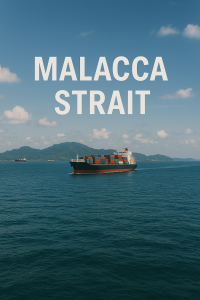The Malacca Strait is one of the world’s busiest and most strategically important waterways, linking the Indian and Pacific Oceans. While its role in global trade is well-known, many intriguing aspects of its history, geography, and challenges remain less explored. This article reveals fascinating facts about the Malacca Strait, from its economic significance to its historical tales of piracy and exploration.

Geographic Overview
The Malacca Strait stretches approximately 900 kilometers (560 miles) between the Malay Peninsula and the Indonesian island of Sumatra. At its narrowest point, it measures just 1.5 nautical miles (2.8 kilometers) wide, making it one of the world’s most significant chokepoints for maritime traffic. This strategic location serves as a critical passage for vessels traveling between Europe, the Middle East, and East Asia.The strait is not only a vital shipping route but also a rich ecological zone, home to diverse marine life and unique ecosystems. The waters are characterized by shallow depths and numerous islands, which can pose navigational challenges for large vessels.
Economic Significance
The Malacca Strait is a crucial artery for global trade, with an estimated 80% of the oil transported to Northeast Asia passing through its waters. According to reports, around 3.5 trillion USD worth of goods transit through this strait annually, including two-thirds of China’s maritime trade volume and 40% of Japan’s maritime trade.
Key Statistics
- Vessel Traffic: Approximately 84,000 vessels transit the strait each year, including container ships, oil tankers, and bulk carriers.
- Trade Volume: The strait handles about one-third of the world’s traded goods, making it an essential route for international commerce.
- Oil Transport: It is estimated that 10 million barrels of oil per day flow through the strait, underscoring its importance in global energy supply chains.
These figures highlight not only the economic importance of the Malacca Strait but also its role as a critical link in the global supply chain.
Historical Context
The Malacca Strait has a rich history that dates back centuries. It has been a vital trade route since ancient times, facilitating commerce between East and West. The region was historically dominated by various empires and kingdoms, including the Srivijaya Empire and later the Sultanate of Malacca in the 15th century.
Piracy and Exploration
Throughout history, piracy has been a persistent issue in the Malacca Strait. The narrow passage made it an ideal location for pirates to ambush trading vessels. In response to these threats, various naval powers established control over the strait to protect their shipping interests.Notable explorers such as Ferdinand Magellan navigated these waters during their voyages in search of new trade routes. The strait’s historical significance as a crossroads of cultures and commerce continues to influence regional politics today.
Environmental Challenges
While the Malacca Strait plays a vital role in global trade, it also faces significant environmental challenges. Increased shipping traffic contributes to pollution, habitat destruction, and marine biodiversity loss.
Pollution Concerns
Oil spills from tankers pose a severe threat to the fragile marine ecosystem. Additionally, ballast water discharged by ships can introduce invasive species that disrupt local habitats. Efforts are underway to implement stricter regulations on waste disposal and pollution control in order to protect this vital waterway.
Security Issues
The strategic importance of the Malacca Strait also makes it a focal point for security concerns. The region has faced threats from piracy and terrorism, prompting increased naval patrols by littoral states such as Malaysia, Indonesia, and Singapore.
Anti-Piracy Measures
In recent years, regional cooperation has strengthened anti-piracy efforts. Initiatives such as the Malacca Strait Patrols involve joint naval exercises among neighboring countries to enhance maritime security. These collaborative efforts aim to deter piracy and ensure safe passage for commercial vessels.
Technological Advancements
Advancements in technology have significantly impacted navigation through the Malacca Strait. Modern ships are equipped with sophisticated navigation systems that enhance safety and efficiency while traversing these busy waters.
GPS and AIS
Global Positioning System (GPS) technology allows vessels to navigate with precision while Automatic Identification Systems (AIS) enable real-time tracking of ship movements. These technologies help prevent collisions and improve overall maritime safety.
Cultural Significance
The Malacca Strait is not only an economic hub but also a cultural melting pot. The diverse communities along its shores reflect a rich tapestry of traditions influenced by centuries of trade and interaction among various cultures.
Heritage Sites
Cities like Malacca (Melaka) in Malaysia boast UNESCO World Heritage status due to their historical significance as trading ports. These sites preserve architectural styles from different eras that showcase cultural exchanges between traders from Europe, Asia, and beyond.
Future Outlook
As global trade continues to evolve, so too will the dynamics surrounding the Malacca Strait. The rise of e-commerce and changing shipping patterns may impact traffic volumes through this critical waterway.
Economic Growth
With countries like China continuing their rapid economic growth—alongside emerging markets in Southeast Asia—the importance of the Malacca Strait is expected to increase further. Investments in port infrastructure and logistics capabilities will be essential for accommodating future demands on this vital route.
Conclusion
The Malacca Strait stands as one of the world’s most significant maritime corridors, linking economies across continents while facilitating global trade flows. Its strategic importance cannot be overstated; however, it also faces challenges related to environmental sustainability, security threats from piracy, and geopolitical tensions among regional powers.Understanding these complexities is crucial for stakeholders involved in maritime operations—ranging from shipping companies to policymakers—who must navigate this vital waterway effectively while ensuring its preservation for future generations.As we continue exploring our oceans today—whether through commercial shipping or recreational boating—we honor these traditions passed down through generations while navigating toward safer horizons together

